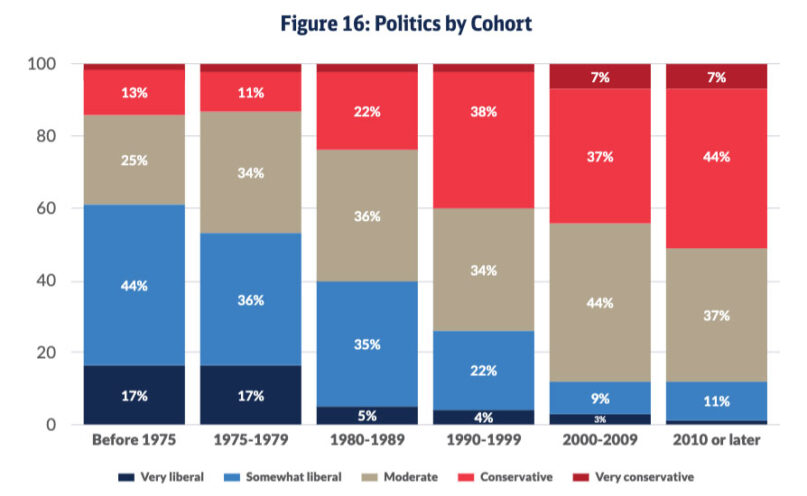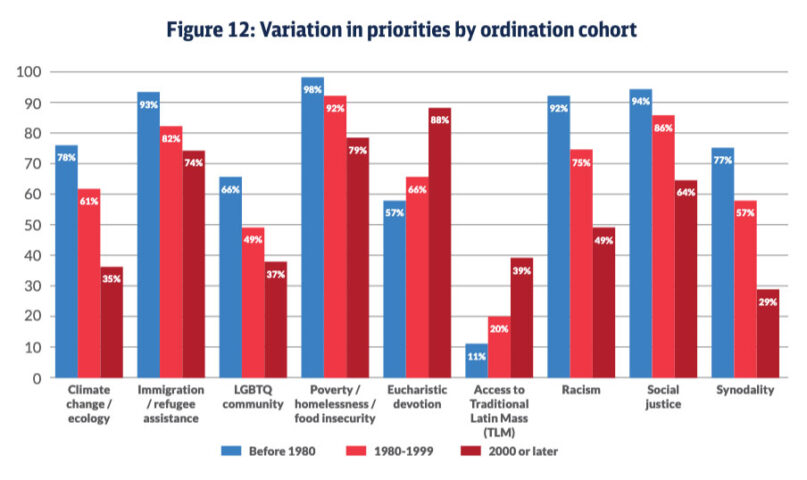(RNS) — For decades, older priests have complained about conservative younger priests who have been coming out of seminaries in recent years, while those younger priests have complained about old liberal priests. The views of younger priests are especially important because they are the future of the American church. Us old guys are dying off.
“The 2025 National Study of Catholic Priests,” released this month by the Catholic Project of The Catholic University of America, gives us data on which to reflect as the church faces its future.
When priests were asked by the project to describe their political view, the responses show an increase in political conservatism among younger generations of priests. The change began in 1980, the year Ronald Reagan was elected, and continued to grow over time no matter who was president.
“Among those ordained before 1975, 61% identified as ‘very’ or ‘somewhat’ liberal and less than 15% as conservative,” the study reports. Among those ordained since 2010, nearly half (51%) identified as ‘very’ or ‘somewhat’ conservative, and only about one in ten as liberal.”
The political leanings of younger and older priests are the reverse of those of the Catholic population at large, where the older generations are more conservative than younger generations.

Politics by Cohort. Chart courtesy The Catholic Project
Of Catholics age 65 and older, 43% describe themselves as conservative, while only 26% of those under 30 say the same, according to data provided to me by Public Religion Research Institute (PRRI) based on their 2024 study of partisanship among Catholic voters. PRRI also has 25% of American Catholics under 50 identifying as liberal.
These young priests, in other words, are even more conservative than Catholics 65 and older.
According to the national priest study, the priests’ theological views followed a similar pattern across generations, though “with an even sharper decline in progressivism and a stronger consolidation on the conservative side.” Thus, theological views revealed an even sharper polarization than political views.
Among “priests ordained before 1975, more than 70% described themselves as theologically progressive, while in the 2010-or-later cohort only 8% did so,” the report says.
It’s not difficult to explain where this conservative streak came from. After Pope John Paul II was elected in 1978, seminaries became more conservative as John Paul appointed conservative bishops. He also appointed Cardinal Joseph Ratzinger to head the Vatican doctrine office. Ratzinger cracked down on progressive theologians, chasing them out of seminaries.
Some bishops are trying to turn their seminaries around. The archbishop of Detroit, for example, has removed three professors who had publicly criticized Pope Francis and his teachings. But such reforms, if they happen, will only impact future generations of priests.
As a result of the papacies of John Paul and Pope Benedict XVI, it is not surprising that “over 70% of the youngest priests described themselves as either ‘conservative/orthodox’ or ‘very conservative/orthodox,’ leaving only about one in five in the ‘middle-of-the-road,’” according to the Catholic Project.
Once again, the theological views of younger priests are out of sync with their peers and with the Catholic population. Catholics tend to favor progressive views on married priests, gay marriage, Communion for divorced and remarried Catholics and the use of contraceptives. As a result, in coming decades, Catholic clergy will be even more out of sync with lay Catholics than the clergy is today.
Some argue for ignoring the views of Catholics who aren’t in church most Sundays, who skew less conservative than Catholics who attend Mass weekly. Yet even 40% of weekly Mass attenders support the ordination of women, according to the Pew Research Center.
In addition, more than half of weekly churchgoers favor allowing Catholics to use birth control (72%) and IVF (71%), allowing unmarried couples who live together to go to Communion (59%) and allowing women to become deacons (54%). All of this is currently not allowed by the church.
In any case, writing off Catholics who do not go to Mass weekly would be devastating for the church.
As older progressive priests retire or die, younger conservative priests will have a profound impact on parish life. When given a list of pastoral issues and asked which should be the priorities of the church, priests of all generations agreed on such issues as youth and young adult ministry, family formation and marriage preparation and evangelization, but there was less consensus on other issues.
“On issues such as climate change, immigration, LGBTQ issues, poverty, racism, social justice, and synodality, prioritization diminishes” as age goes down, the report showed. “It is the opposite in the case of Eucharistic devotion and access to the TLM.”

Variation in priorities by ordination time period. Chart courtesy The Catholic Project
Especially disconcerting is the low support for synodality (29%), a priority for Francis that fell on deaf ears with most younger priests. For all his popularity inside and outside the American church, the Francis papacy did not have much of an impact on these priests.
Younger priests were also less likely than older priests to worry about the role of women in the church. Of priests ordained before 1980, 76% said women did not have enough influence in the church, but only 31% of those ordained in 2000 or later said the same.
The priest study showed other areas of concern for young priests, including burnout and loneliness. Almost half of priests ordained since 2000 report that they are expected to do too many things “that go beyond (their) calling as priests.” Only 13% of priests ordained before 1980 say the same.
“Are these men being asked to do things that were not asked of previous generations of priests,” asks the study, “or is it just that they do not see those things as a priest’s responsibility while previous generations did?”
Whatever the answer, the National Study of Catholic Priests raises concerns about the future of priestly ministry in the American Catholic Church. If the younger clergy aggressively push their political and theological views on the Catholic people, church attendance will continue downward, and fewer Americans will identify as Catholic.



